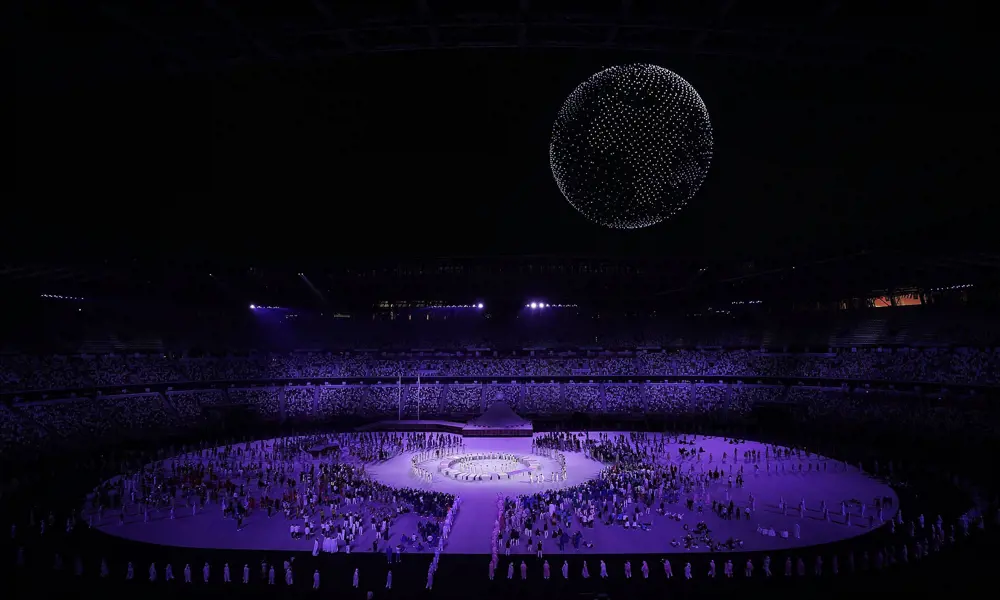
How do drone displays work?
In recent years, coordinated drone light shows have become more prominent. These displays are performed by illuminated, synchronised and choreographed groups of drones that arrange themselves into various aerial formations, from cars and words to moving patterns and animals. While the drones themselves are not unusual (How does that work? Drones, Ingenia 73), they are fitted with LEDs (light-emitting diodes) in different colours to light up the night skies.
Coordinated drone fleets came to prominence in a 2012 TED talk about autonomous robots that swarm or flock, sense each other, and form teams, delivered by Professor Vijay Kumar, the University of Pennsylvania’s Dean of Engineering. That same year, a coordinated display of 50 drones over Linz in Austria at the Ars Electronica Festival was the first of its kind and set the world record for ‘most UAVs airborne simultaneously’. Since then, drone displays have been used for advertising purposes, PR stunts, and at major events such as Olympic and Paralympic ceremonies. In March 2021, the world record was broken by luxury car brand GENESIS, which flew 3,281 drones in formation above Shanghai to announce its arrival into the Chinese market.
To create these shows, designers first put together a storyboard and timeline that shows the required images and effects, then software engineers create a synchronised flight path for each individual drone. Advances in technology have made it possible to fly hundred of drones together – a complex algorithm directs the drones to where they need to be throughout the display and onboard cameras and proximity sensors ensure that they don’t collide in the air. For the drones to act as a swarm, each drone communicates and shares data with its neighbours – knowing the intended shape of the display via the algorithm and communicating with drones in the immediate surroundings is enough to form the intended shape. Drones do have limited processing power in their onboard computers, but technology is advancing all the time so in future they could move adaptively by themselves without needing to be programmed in advance.
A ground control station sends the unique program via radio signal to the drone and when the time is right – the batteries fully charged and the flight area clear – the drones set off to complete the storyboard in the sky. The ground control station is operated by a pilot, or pilots, who continuously monitors the flight paths. They are also usually aviation experts with specialist knowledge of airspace restrictions and laws prohibiting drone use, as well as having a keen eye on the weather – displays can’t happen if it’s raining or if there are high winds.
While coordinated drone light shows are being seen more regularly, several factors do limit their use, including high costs, the time and labour needed to produce them, and regulatory and safety approvals. They could also potentially disrupt birds’ flight patterns. However, drone light shows could be an environmentally friendly alternative to fireworks: drones don’t produce any polluting emissions or loud noises, are reusable, and reduce the risk of wildfires in places with drier climates.
So, while you’re still more likely to see such displays at big events or for advertising purposes, a coordinated drone light show could soon be at your next local Guy Fawkes Night celebration.
Keep up-to-date with Ingenia for free
SubscribeRelated content
Technology & robotics

When will cars drive themselves?
There are many claims made about the progress of autonomous vehicles and their imminent arrival on UK roads. What progress has been made and how have measures that have already been implemented increased automation?

Autonomous systems
The Royal Academy of Engineering hosted an event on Innovation in Autonomous Systems, focusing on the potential of autonomous systems to transform industry and business and the evolving relationship between people and technology.

Hydroacoustics
Useful for scientists, search and rescue operations and military forces, the size, range and orientation of an object underneath the surface of the sea can be determined by active and passive sonar devices. Find out how they are used to generate information about underwater objects.

Instilling robots with lifelong learning
In the basement of an ageing red-brick Oxford college, a team of engineers is changing the shape of robot autonomy. Professor Paul Newman FREng explained to Michael Kenward how he came to lead the Oxford Mobile Robotics Group and why the time is right for a revolution in autonomous technologies.
Other content from Ingenia
Quick read

- Environment & sustainability
- Opinion
A young engineer’s perspective on the good, the bad and the ugly of COP27

- Environment & sustainability
- Issue 95
How do we pay for net zero technologies?
Quick read

- Transport
- Mechanical
- How I got here
Electrifying trains and STEMAZING outreach

- Civil & structural
- Environment & sustainability
- Issue 95